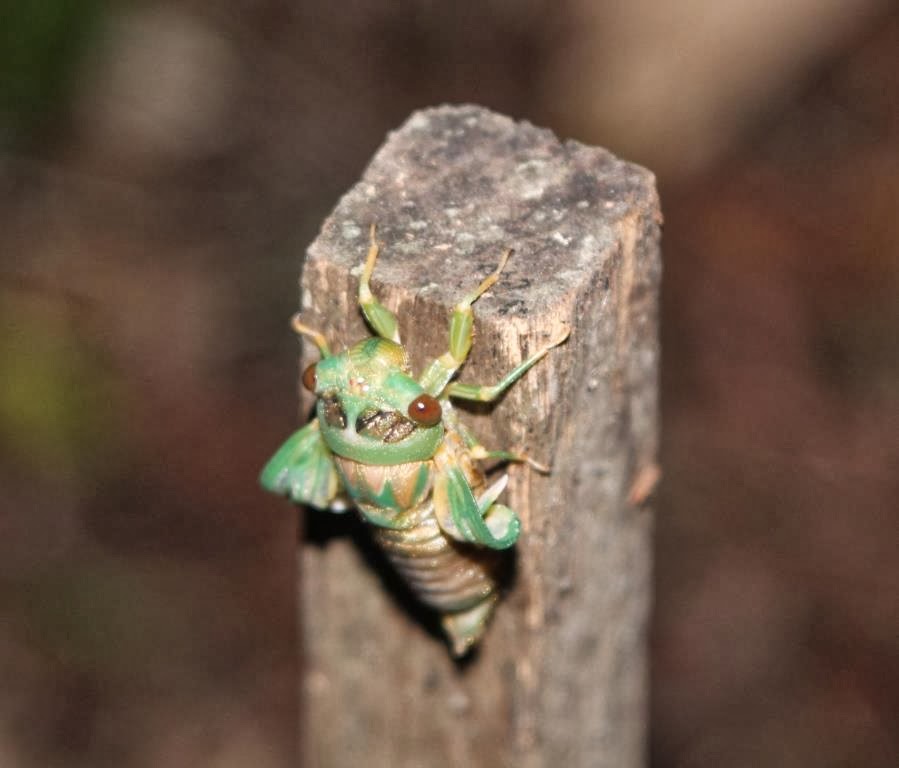 |
| Christmas Beetle Anoplognathus sp. |
 |
| Christmas Beetle Anoplognathus sp. |
 |
| Black Nail Beetle Repsimus manicatus |
 |
| 'Christmas Beetle' |
Jumping Beetles on Creek Sandpaper Fig
Coutts Crossing
Up until a few days ago the incessant call of ciacdas was all pervading, even into the evening. A number of species occur locally including the Yellow Monday Cyclochila australasiae , Razor Grinder Henicopsaltria eydouxii, Psaltoda pictibasis and others that I am having identified at present. P. pictibasis is found east of the Great Dividing Range and in NSW there are records from only Tabulum, Iluka and Port Macquarie. The latter locality requires confirmation. So my record at Coutts Crossing is a new locality for the species. Cicadas emerge from the soil during the summer after spending years underground feeding on the sap from plant roots. The larvae climb up onto tree trunks and other objects, and shed their nymphal cases (exuviae). A small post at the edge of our driveway has a cluster of nymphal cases at the top. Once fully emerged and the wings open and dry out they fly to a tree to feed and breed.
Psaltoda sp. cicada emerging from Nymphal case Coutts Crsossing
Cicada nymphal cases on stump Coutts Crossing
Yellow Monday Cyclochila australasiae and
nymphal cases Ebor Falls
Cicada Psaltoda pictibasis Coutts Crossing
Razor Grinder Henicopsaltria eydouxii Orara River Coutts Crossing
Floury Baker Aleeta curvicosta Coutts Crossing
Double Drummer Thopha saccata Nymboi-Binderay National Park
Identifications provided so far have been by Ian Buddle, Max Moulds, Frank Pierce and Lindsay Popple .
For the past few mornings cicadas haven't dominated the sounds of the bush as they have been doing for some time. The cooler weather seems to have quietened them down and the fact that they provide a rich source of food for many bird species means that their numbers may be dwindling due to predation. For the past few mornings, the chattering of Spangled Drongos and the calls of Noisy Friarbirds, Little Friarbirds, Noisy Miners, Blue-faced Honeyeaters and Little Wattlebirds have dominated. Large numbers of these birds have been feasting on the beetles and cicadas. At least 10 Spangled Drongos, including dependent young being fed by adults, were present but as they are very active this estimate is probably understating the real number present. A flock of 13 Blue-faced Honeyeaters and a number Noisy Friarbirds, including an adult feeding a juvenile, were also present.
A family of Pacific Bazas, an adult and juvenile Olive-backed Orioles and a couple of Dollarbirds have also joined in the feast.










Hi Greg.
ReplyDeleteGreat post and you have some excellent photos of the local cicada emergence (indeed a spectacular one this season). Just a couple of thoughts on the IDs of a few species. Your top three photos look like a species of Psaltoda (head vs thorax proportions not quite right for Greengrocer). It is still attaining its true colours following emergence. The Cyclochila australasiae photo further down the page is representative of a morph known as Masked Devil. This morph is almost always found at high elevations, so it makes sense that you found it at Ebor. I believe that Coutts Crossing would be a new locality record for Psaltoda pictibasis. That species extends quite some way south west of the Great Dividing Range as well. I have found it around Dubbo. The bottom two illustrations are of Floury Baker (Aleeta curvicosta) and Double Drummer (Thopha saccata) respectively. Thanks again for this post.
Regards,
Lindsay Popple.
Thanks Lindsay, Frank Pierce also suggested Floury Baker and Double Drummer for the two unidentified species. The Coutts Crossing Floury Baker doesn't have as much 'flour' on its body as in other photos that I have viewed. Does this wear off or does it vary geographically? Thanks for those comments on the emerging green cicada.
ReplyDeleteRegards
Greg
No worries Greg. The 'flour' does wear off Floury Baker specimens as they get older. So as the season wears on (from around late January) many of the specimens become mostly free of this covering of fine hairs. In contrast, freshly emerged specimens are very 'chalky'.
DeleteRegards,
Lindsay.
An interesting post. They really do form a large part of the sounds of an Australian summer.
ReplyDeleteI am glad that you found the post interesting. I photographed a Black Prince last Saturday so it can be added to our local list of cicadas.
ReplyDelete